Projects Negotiation and Conflict Report for Queensland Health Payroll Program
VerifiedAdded on 2023/06/08
|7
|2319
|427
AI Summary
This report discusses the negotiation and conflict resolution strategies for four projects under the Queensland Health Payroll Program. It includes the negotiating positions and potential conflicts of the participants, recommended negotiation methods, and preferred forms of procurement as outcomes.
Contribute Materials
Your contribution can guide someone’s learning journey. Share your
documents today.
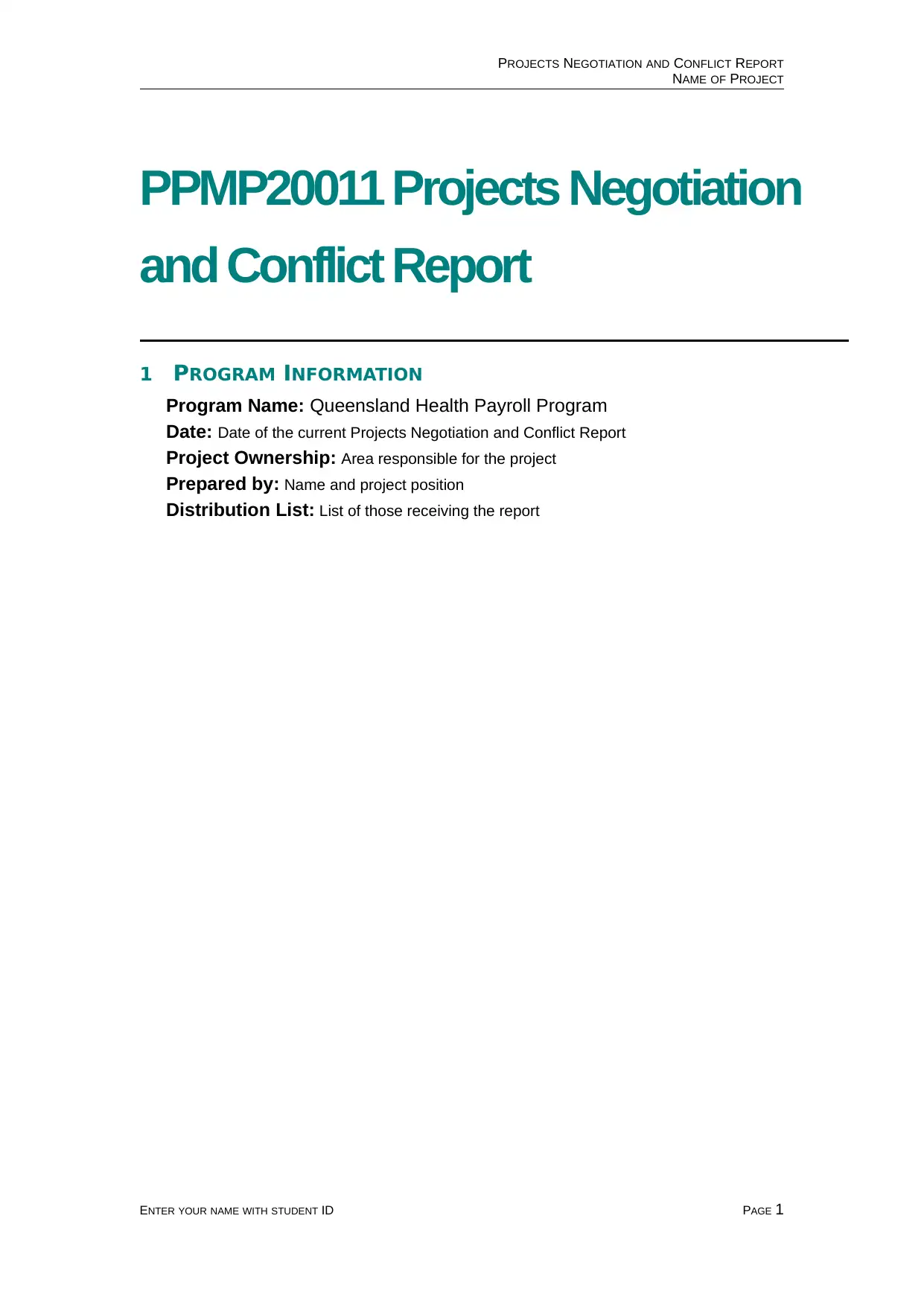
PROJECTS NEGOTIATION AND CONFLICT REPORT
NAME OF PROJECT
PPMP20011 Projects Negotiation
and Conflict Report
1 PROGRAM INFORMATION
Program Name: Queensland Health Payroll Program
Date: Date of the current Projects Negotiation and Conflict Report
Project Ownership: Area responsible for the project
Prepared by: Name and project position
Distribution List: List of those receiving the report
ENTER YOUR NAME WITH STUDENT ID PAGE 1
NAME OF PROJECT
PPMP20011 Projects Negotiation
and Conflict Report
1 PROGRAM INFORMATION
Program Name: Queensland Health Payroll Program
Date: Date of the current Projects Negotiation and Conflict Report
Project Ownership: Area responsible for the project
Prepared by: Name and project position
Distribution List: List of those receiving the report
ENTER YOUR NAME WITH STUDENT ID PAGE 1
Secure Best Marks with AI Grader
Need help grading? Try our AI Grader for instant feedback on your assignments.
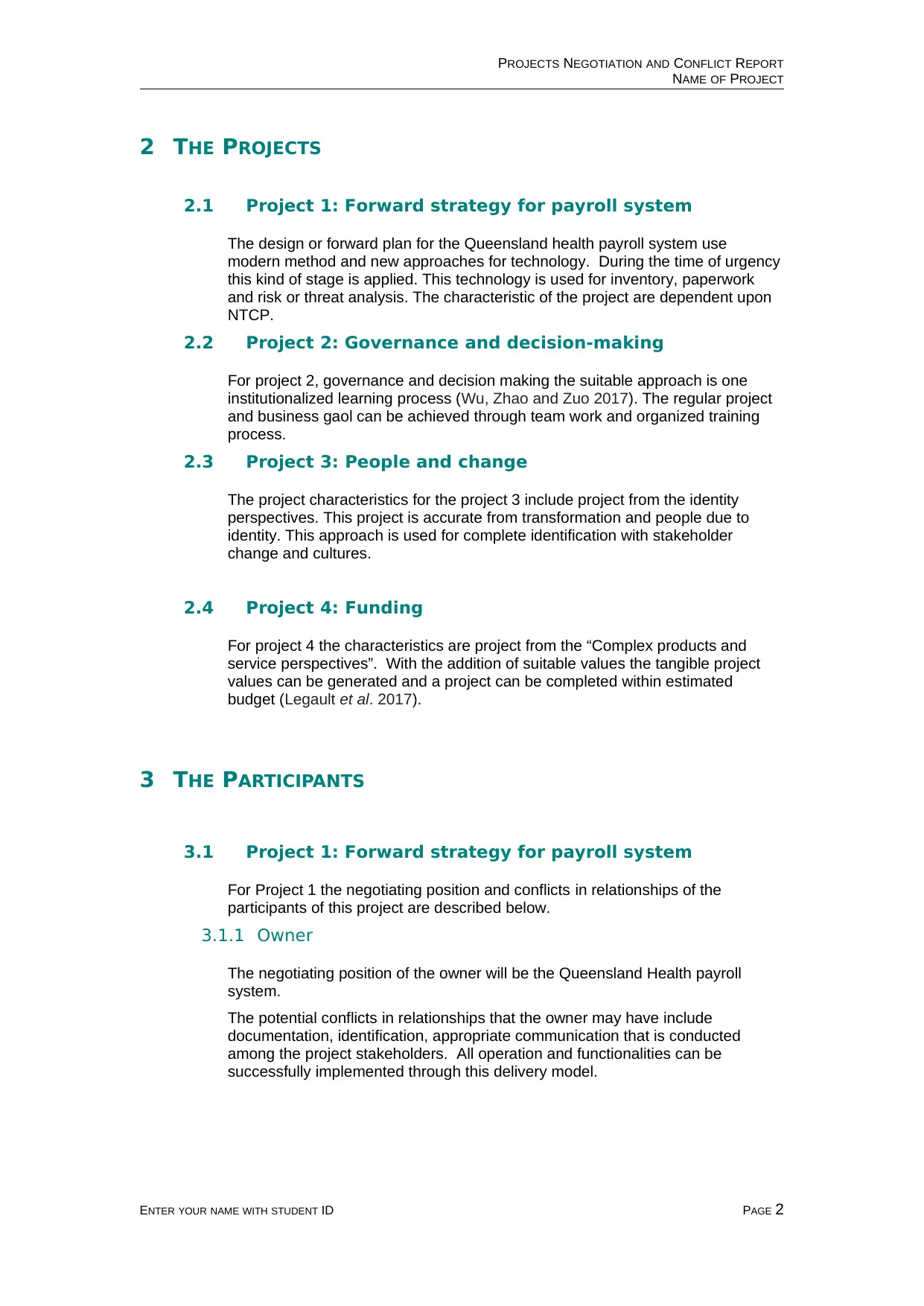
PROJECTS NEGOTIATION AND CONFLICT REPORT
NAME OF PROJECT
2 THE PROJECTS
2.1 Project 1: Forward strategy for payroll system
The design or forward plan for the Queensland health payroll system use
modern method and new approaches for technology. During the time of urgency
this kind of stage is applied. This technology is used for inventory, paperwork
and risk or threat analysis. The characteristic of the project are dependent upon
NTCP.
2.2 Project 2: Governance and decision-making
For project 2, governance and decision making the suitable approach is one
institutionalized learning process (Wu, Zhao and Zuo 2017). The regular project
and business gaol can be achieved through team work and organized training
process.
2.3 Project 3: People and change
The project characteristics for the project 3 include project from the identity
perspectives. This project is accurate from transformation and people due to
identity. This approach is used for complete identification with stakeholder
change and cultures.
2.4 Project 4: Funding
For project 4 the characteristics are project from the “Complex products and
service perspectives”. With the addition of suitable values the tangible project
values can be generated and a project can be completed within estimated
budget (Legault et al. 2017).
3 THE PARTICIPANTS
3.1 Project 1: Forward strategy for payroll system
For Project 1 the negotiating position and conflicts in relationships of the
participants of this project are described below.
3.1.1 Owner
The negotiating position of the owner will be the Queensland Health payroll
system.
The potential conflicts in relationships that the owner may have include
documentation, identification, appropriate communication that is conducted
among the project stakeholders. All operation and functionalities can be
successfully implemented through this delivery model.
ENTER YOUR NAME WITH STUDENT ID PAGE 2
NAME OF PROJECT
2 THE PROJECTS
2.1 Project 1: Forward strategy for payroll system
The design or forward plan for the Queensland health payroll system use
modern method and new approaches for technology. During the time of urgency
this kind of stage is applied. This technology is used for inventory, paperwork
and risk or threat analysis. The characteristic of the project are dependent upon
NTCP.
2.2 Project 2: Governance and decision-making
For project 2, governance and decision making the suitable approach is one
institutionalized learning process (Wu, Zhao and Zuo 2017). The regular project
and business gaol can be achieved through team work and organized training
process.
2.3 Project 3: People and change
The project characteristics for the project 3 include project from the identity
perspectives. This project is accurate from transformation and people due to
identity. This approach is used for complete identification with stakeholder
change and cultures.
2.4 Project 4: Funding
For project 4 the characteristics are project from the “Complex products and
service perspectives”. With the addition of suitable values the tangible project
values can be generated and a project can be completed within estimated
budget (Legault et al. 2017).
3 THE PARTICIPANTS
3.1 Project 1: Forward strategy for payroll system
For Project 1 the negotiating position and conflicts in relationships of the
participants of this project are described below.
3.1.1 Owner
The negotiating position of the owner will be the Queensland Health payroll
system.
The potential conflicts in relationships that the owner may have include
documentation, identification, appropriate communication that is conducted
among the project stakeholders. All operation and functionalities can be
successfully implemented through this delivery model.
ENTER YOUR NAME WITH STUDENT ID PAGE 2
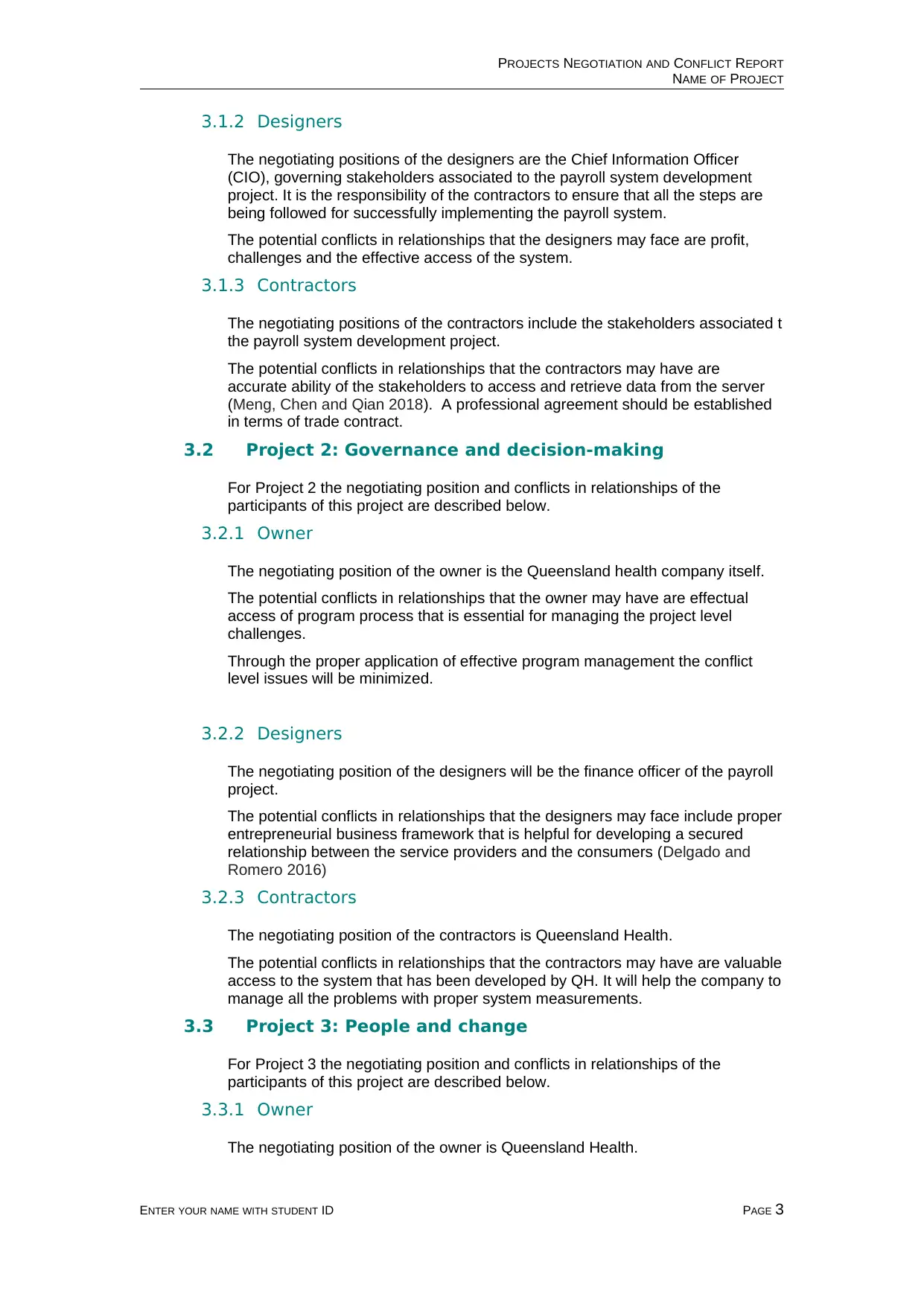
PROJECTS NEGOTIATION AND CONFLICT REPORT
NAME OF PROJECT
3.1.2 Designers
The negotiating positions of the designers are the Chief Information Officer
(CIO), governing stakeholders associated to the payroll system development
project. It is the responsibility of the contractors to ensure that all the steps are
being followed for successfully implementing the payroll system.
The potential conflicts in relationships that the designers may face are profit,
challenges and the effective access of the system.
3.1.3 Contractors
The negotiating positions of the contractors include the stakeholders associated t
the payroll system development project.
The potential conflicts in relationships that the contractors may have are
accurate ability of the stakeholders to access and retrieve data from the server
(Meng, Chen and Qian 2018). A professional agreement should be established
in terms of trade contract.
3.2 Project 2: Governance and decision-making
For Project 2 the negotiating position and conflicts in relationships of the
participants of this project are described below.
3.2.1 Owner
The negotiating position of the owner is the Queensland health company itself.
The potential conflicts in relationships that the owner may have are effectual
access of program process that is essential for managing the project level
challenges.
Through the proper application of effective program management the conflict
level issues will be minimized.
3.2.2 Designers
The negotiating position of the designers will be the finance officer of the payroll
project.
The potential conflicts in relationships that the designers may face include proper
entrepreneurial business framework that is helpful for developing a secured
relationship between the service providers and the consumers (Delgado and
Romero 2016)
3.2.3 Contractors
The negotiating position of the contractors is Queensland Health.
The potential conflicts in relationships that the contractors may have are valuable
access to the system that has been developed by QH. It will help the company to
manage all the problems with proper system measurements.
3.3 Project 3: People and change
For Project 3 the negotiating position and conflicts in relationships of the
participants of this project are described below.
3.3.1 Owner
The negotiating position of the owner is Queensland Health.
ENTER YOUR NAME WITH STUDENT ID PAGE 3
NAME OF PROJECT
3.1.2 Designers
The negotiating positions of the designers are the Chief Information Officer
(CIO), governing stakeholders associated to the payroll system development
project. It is the responsibility of the contractors to ensure that all the steps are
being followed for successfully implementing the payroll system.
The potential conflicts in relationships that the designers may face are profit,
challenges and the effective access of the system.
3.1.3 Contractors
The negotiating positions of the contractors include the stakeholders associated t
the payroll system development project.
The potential conflicts in relationships that the contractors may have are
accurate ability of the stakeholders to access and retrieve data from the server
(Meng, Chen and Qian 2018). A professional agreement should be established
in terms of trade contract.
3.2 Project 2: Governance and decision-making
For Project 2 the negotiating position and conflicts in relationships of the
participants of this project are described below.
3.2.1 Owner
The negotiating position of the owner is the Queensland health company itself.
The potential conflicts in relationships that the owner may have are effectual
access of program process that is essential for managing the project level
challenges.
Through the proper application of effective program management the conflict
level issues will be minimized.
3.2.2 Designers
The negotiating position of the designers will be the finance officer of the payroll
project.
The potential conflicts in relationships that the designers may face include proper
entrepreneurial business framework that is helpful for developing a secured
relationship between the service providers and the consumers (Delgado and
Romero 2016)
3.2.3 Contractors
The negotiating position of the contractors is Queensland Health.
The potential conflicts in relationships that the contractors may have are valuable
access to the system that has been developed by QH. It will help the company to
manage all the problems with proper system measurements.
3.3 Project 3: People and change
For Project 3 the negotiating position and conflicts in relationships of the
participants of this project are described below.
3.3.1 Owner
The negotiating position of the owner is Queensland Health.
ENTER YOUR NAME WITH STUDENT ID PAGE 3
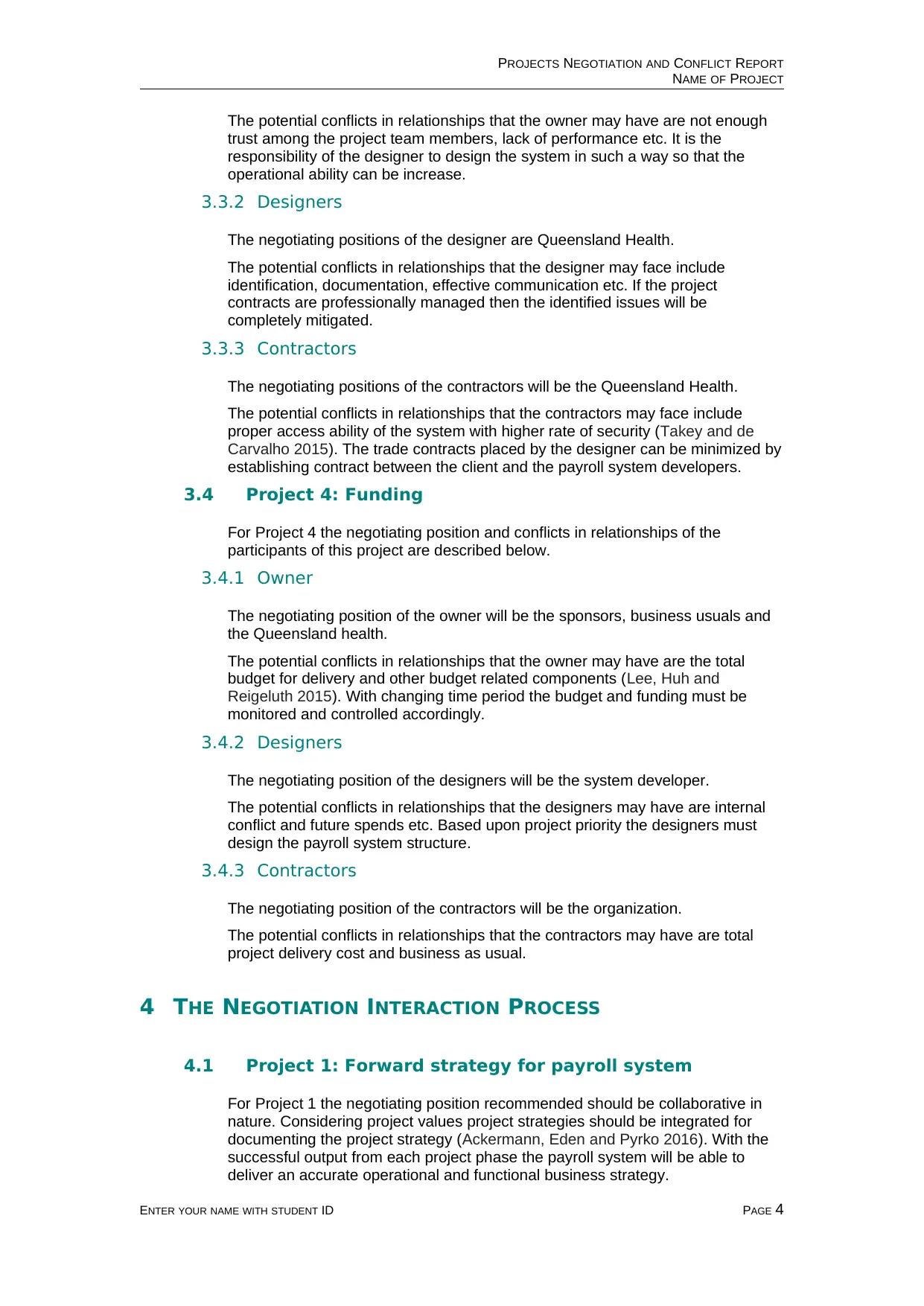
PROJECTS NEGOTIATION AND CONFLICT REPORT
NAME OF PROJECT
The potential conflicts in relationships that the owner may have are not enough
trust among the project team members, lack of performance etc. It is the
responsibility of the designer to design the system in such a way so that the
operational ability can be increase.
3.3.2 Designers
The negotiating positions of the designer are Queensland Health.
The potential conflicts in relationships that the designer may face include
identification, documentation, effective communication etc. If the project
contracts are professionally managed then the identified issues will be
completely mitigated.
3.3.3 Contractors
The negotiating positions of the contractors will be the Queensland Health.
The potential conflicts in relationships that the contractors may face include
proper access ability of the system with higher rate of security (Takey and de
Carvalho 2015). The trade contracts placed by the designer can be minimized by
establishing contract between the client and the payroll system developers.
3.4 Project 4: Funding
For Project 4 the negotiating position and conflicts in relationships of the
participants of this project are described below.
3.4.1 Owner
The negotiating position of the owner will be the sponsors, business usuals and
the Queensland health.
The potential conflicts in relationships that the owner may have are the total
budget for delivery and other budget related components (Lee, Huh and
Reigeluth 2015). With changing time period the budget and funding must be
monitored and controlled accordingly.
3.4.2 Designers
The negotiating position of the designers will be the system developer.
The potential conflicts in relationships that the designers may have are internal
conflict and future spends etc. Based upon project priority the designers must
design the payroll system structure.
3.4.3 Contractors
The negotiating position of the contractors will be the organization.
The potential conflicts in relationships that the contractors may have are total
project delivery cost and business as usual.
4 THE NEGOTIATION INTERACTION PROCESS
4.1 Project 1: Forward strategy for payroll system
For Project 1 the negotiating position recommended should be collaborative in
nature. Considering project values project strategies should be integrated for
documenting the project strategy (Ackermann, Eden and Pyrko 2016). With the
successful output from each project phase the payroll system will be able to
deliver an accurate operational and functional business strategy.
ENTER YOUR NAME WITH STUDENT ID PAGE 4
NAME OF PROJECT
The potential conflicts in relationships that the owner may have are not enough
trust among the project team members, lack of performance etc. It is the
responsibility of the designer to design the system in such a way so that the
operational ability can be increase.
3.3.2 Designers
The negotiating positions of the designer are Queensland Health.
The potential conflicts in relationships that the designer may face include
identification, documentation, effective communication etc. If the project
contracts are professionally managed then the identified issues will be
completely mitigated.
3.3.3 Contractors
The negotiating positions of the contractors will be the Queensland Health.
The potential conflicts in relationships that the contractors may face include
proper access ability of the system with higher rate of security (Takey and de
Carvalho 2015). The trade contracts placed by the designer can be minimized by
establishing contract between the client and the payroll system developers.
3.4 Project 4: Funding
For Project 4 the negotiating position and conflicts in relationships of the
participants of this project are described below.
3.4.1 Owner
The negotiating position of the owner will be the sponsors, business usuals and
the Queensland health.
The potential conflicts in relationships that the owner may have are the total
budget for delivery and other budget related components (Lee, Huh and
Reigeluth 2015). With changing time period the budget and funding must be
monitored and controlled accordingly.
3.4.2 Designers
The negotiating position of the designers will be the system developer.
The potential conflicts in relationships that the designers may have are internal
conflict and future spends etc. Based upon project priority the designers must
design the payroll system structure.
3.4.3 Contractors
The negotiating position of the contractors will be the organization.
The potential conflicts in relationships that the contractors may have are total
project delivery cost and business as usual.
4 THE NEGOTIATION INTERACTION PROCESS
4.1 Project 1: Forward strategy for payroll system
For Project 1 the negotiating position recommended should be collaborative in
nature. Considering project values project strategies should be integrated for
documenting the project strategy (Ackermann, Eden and Pyrko 2016). With the
successful output from each project phase the payroll system will be able to
deliver an accurate operational and functional business strategy.
ENTER YOUR NAME WITH STUDENT ID PAGE 4
Secure Best Marks with AI Grader
Need help grading? Try our AI Grader for instant feedback on your assignments.
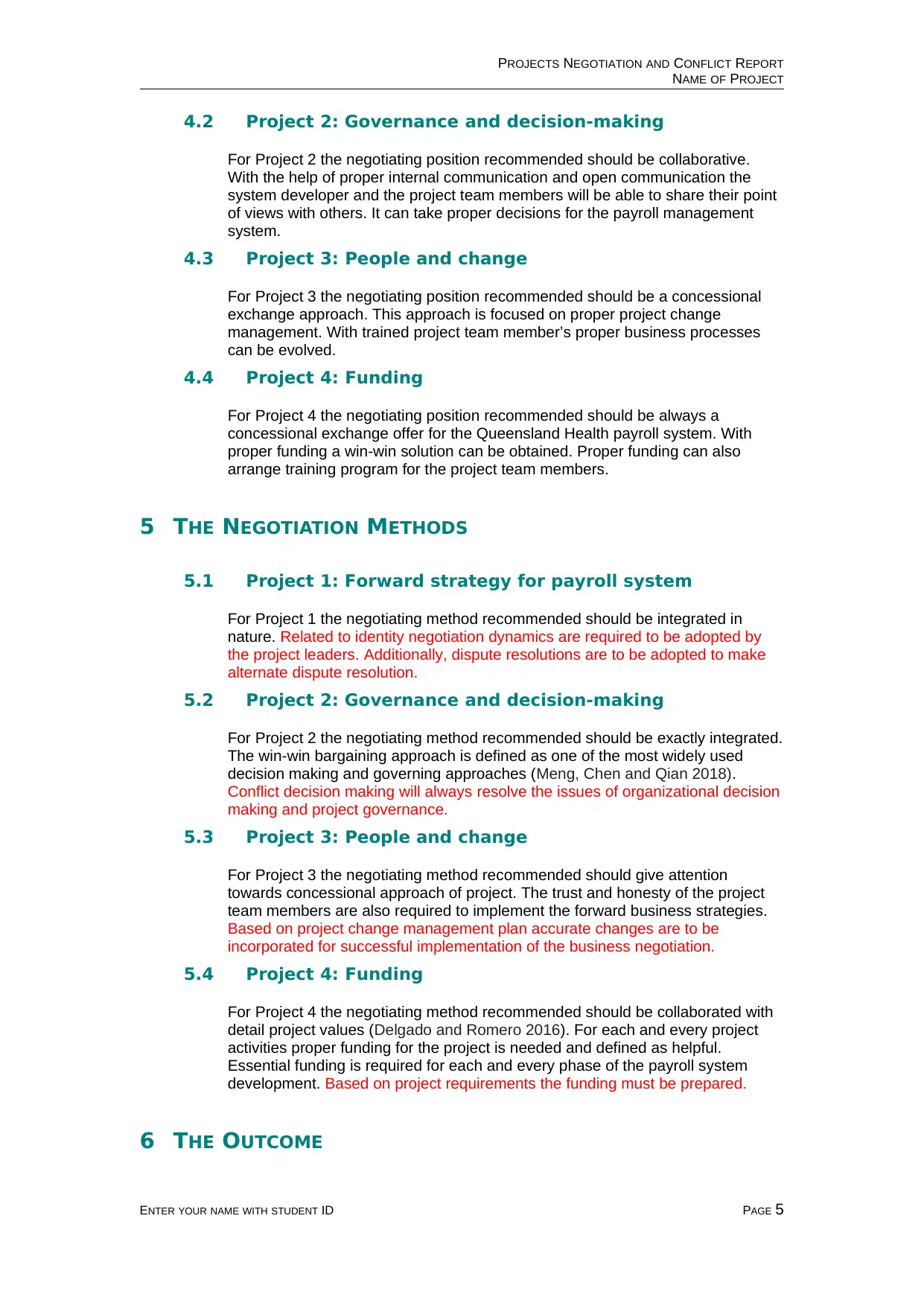
PROJECTS NEGOTIATION AND CONFLICT REPORT
NAME OF PROJECT
4.2 Project 2: Governance and decision-making
For Project 2 the negotiating position recommended should be collaborative.
With the help of proper internal communication and open communication the
system developer and the project team members will be able to share their point
of views with others. It can take proper decisions for the payroll management
system.
4.3 Project 3: People and change
For Project 3 the negotiating position recommended should be a concessional
exchange approach. This approach is focused on proper project change
management. With trained project team member’s proper business processes
can be evolved.
4.4 Project 4: Funding
For Project 4 the negotiating position recommended should be always a
concessional exchange offer for the Queensland Health payroll system. With
proper funding a win-win solution can be obtained. Proper funding can also
arrange training program for the project team members.
5 THE NEGOTIATION METHODS
5.1 Project 1: Forward strategy for payroll system
For Project 1 the negotiating method recommended should be integrated in
nature. Related to identity negotiation dynamics are required to be adopted by
the project leaders. Additionally, dispute resolutions are to be adopted to make
alternate dispute resolution.
5.2 Project 2: Governance and decision-making
For Project 2 the negotiating method recommended should be exactly integrated.
The win-win bargaining approach is defined as one of the most widely used
decision making and governing approaches (Meng, Chen and Qian 2018).
Conflict decision making will always resolve the issues of organizational decision
making and project governance.
5.3 Project 3: People and change
For Project 3 the negotiating method recommended should give attention
towards concessional approach of project. The trust and honesty of the project
team members are also required to implement the forward business strategies.
Based on project change management plan accurate changes are to be
incorporated for successful implementation of the business negotiation.
5.4 Project 4: Funding
For Project 4 the negotiating method recommended should be collaborated with
detail project values (Delgado and Romero 2016). For each and every project
activities proper funding for the project is needed and defined as helpful.
Essential funding is required for each and every phase of the payroll system
development. Based on project requirements the funding must be prepared.
6 THE OUTCOME
ENTER YOUR NAME WITH STUDENT ID PAGE 5
NAME OF PROJECT
4.2 Project 2: Governance and decision-making
For Project 2 the negotiating position recommended should be collaborative.
With the help of proper internal communication and open communication the
system developer and the project team members will be able to share their point
of views with others. It can take proper decisions for the payroll management
system.
4.3 Project 3: People and change
For Project 3 the negotiating position recommended should be a concessional
exchange approach. This approach is focused on proper project change
management. With trained project team member’s proper business processes
can be evolved.
4.4 Project 4: Funding
For Project 4 the negotiating position recommended should be always a
concessional exchange offer for the Queensland Health payroll system. With
proper funding a win-win solution can be obtained. Proper funding can also
arrange training program for the project team members.
5 THE NEGOTIATION METHODS
5.1 Project 1: Forward strategy for payroll system
For Project 1 the negotiating method recommended should be integrated in
nature. Related to identity negotiation dynamics are required to be adopted by
the project leaders. Additionally, dispute resolutions are to be adopted to make
alternate dispute resolution.
5.2 Project 2: Governance and decision-making
For Project 2 the negotiating method recommended should be exactly integrated.
The win-win bargaining approach is defined as one of the most widely used
decision making and governing approaches (Meng, Chen and Qian 2018).
Conflict decision making will always resolve the issues of organizational decision
making and project governance.
5.3 Project 3: People and change
For Project 3 the negotiating method recommended should give attention
towards concessional approach of project. The trust and honesty of the project
team members are also required to implement the forward business strategies.
Based on project change management plan accurate changes are to be
incorporated for successful implementation of the business negotiation.
5.4 Project 4: Funding
For Project 4 the negotiating method recommended should be collaborated with
detail project values (Delgado and Romero 2016). For each and every project
activities proper funding for the project is needed and defined as helpful.
Essential funding is required for each and every phase of the payroll system
development. Based on project requirements the funding must be prepared.
6 THE OUTCOME
ENTER YOUR NAME WITH STUDENT ID PAGE 5
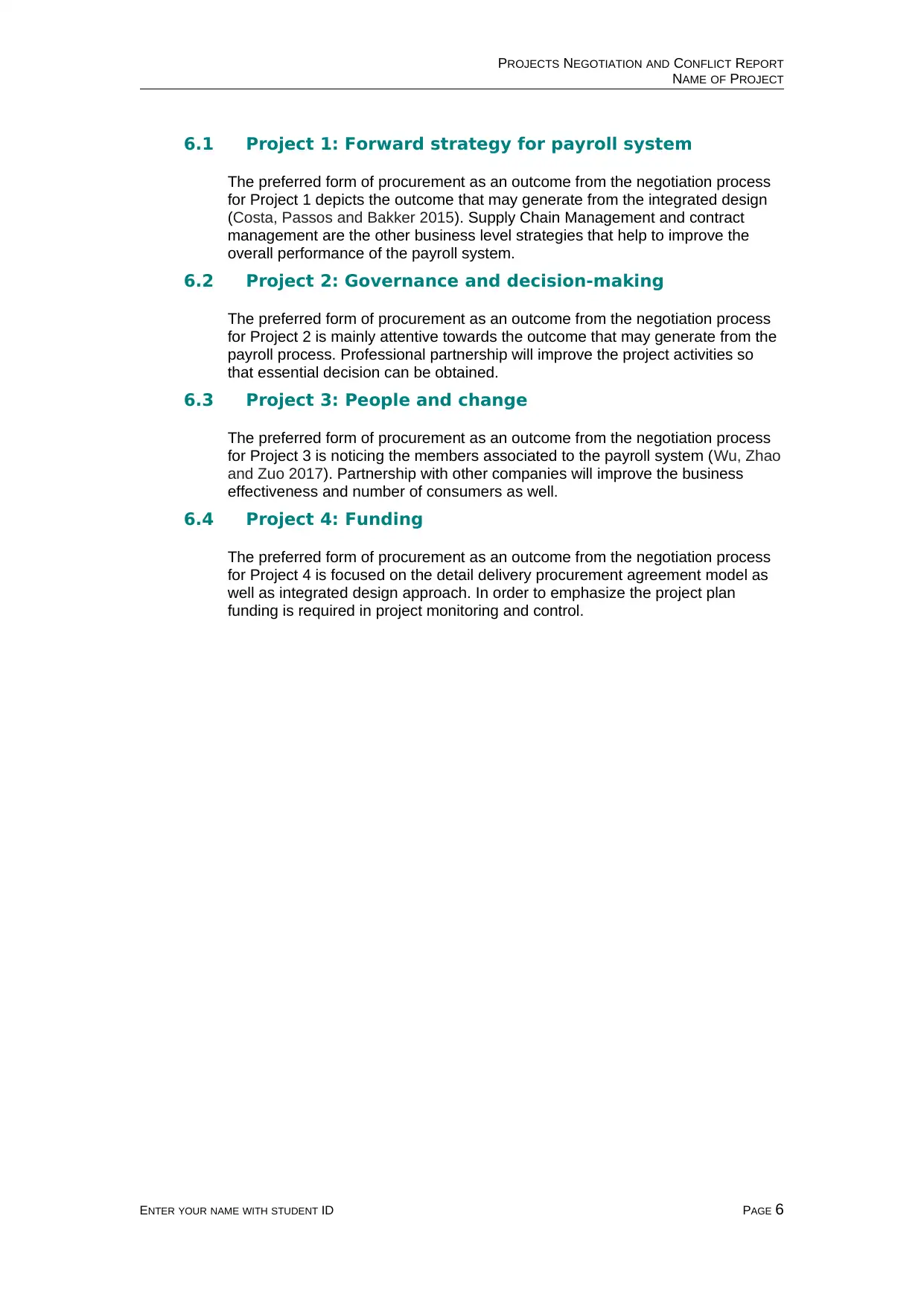
PROJECTS NEGOTIATION AND CONFLICT REPORT
NAME OF PROJECT
6.1 Project 1: Forward strategy for payroll system
The preferred form of procurement as an outcome from the negotiation process
for Project 1 depicts the outcome that may generate from the integrated design
(Costa, Passos and Bakker 2015). Supply Chain Management and contract
management are the other business level strategies that help to improve the
overall performance of the payroll system.
6.2 Project 2: Governance and decision-making
The preferred form of procurement as an outcome from the negotiation process
for Project 2 is mainly attentive towards the outcome that may generate from the
payroll process. Professional partnership will improve the project activities so
that essential decision can be obtained.
6.3 Project 3: People and change
The preferred form of procurement as an outcome from the negotiation process
for Project 3 is noticing the members associated to the payroll system (Wu, Zhao
and Zuo 2017). Partnership with other companies will improve the business
effectiveness and number of consumers as well.
6.4 Project 4: Funding
The preferred form of procurement as an outcome from the negotiation process
for Project 4 is focused on the detail delivery procurement agreement model as
well as integrated design approach. In order to emphasize the project plan
funding is required in project monitoring and control.
ENTER YOUR NAME WITH STUDENT ID PAGE 6
NAME OF PROJECT
6.1 Project 1: Forward strategy for payroll system
The preferred form of procurement as an outcome from the negotiation process
for Project 1 depicts the outcome that may generate from the integrated design
(Costa, Passos and Bakker 2015). Supply Chain Management and contract
management are the other business level strategies that help to improve the
overall performance of the payroll system.
6.2 Project 2: Governance and decision-making
The preferred form of procurement as an outcome from the negotiation process
for Project 2 is mainly attentive towards the outcome that may generate from the
payroll process. Professional partnership will improve the project activities so
that essential decision can be obtained.
6.3 Project 3: People and change
The preferred form of procurement as an outcome from the negotiation process
for Project 3 is noticing the members associated to the payroll system (Wu, Zhao
and Zuo 2017). Partnership with other companies will improve the business
effectiveness and number of consumers as well.
6.4 Project 4: Funding
The preferred form of procurement as an outcome from the negotiation process
for Project 4 is focused on the detail delivery procurement agreement model as
well as integrated design approach. In order to emphasize the project plan
funding is required in project monitoring and control.
ENTER YOUR NAME WITH STUDENT ID PAGE 6
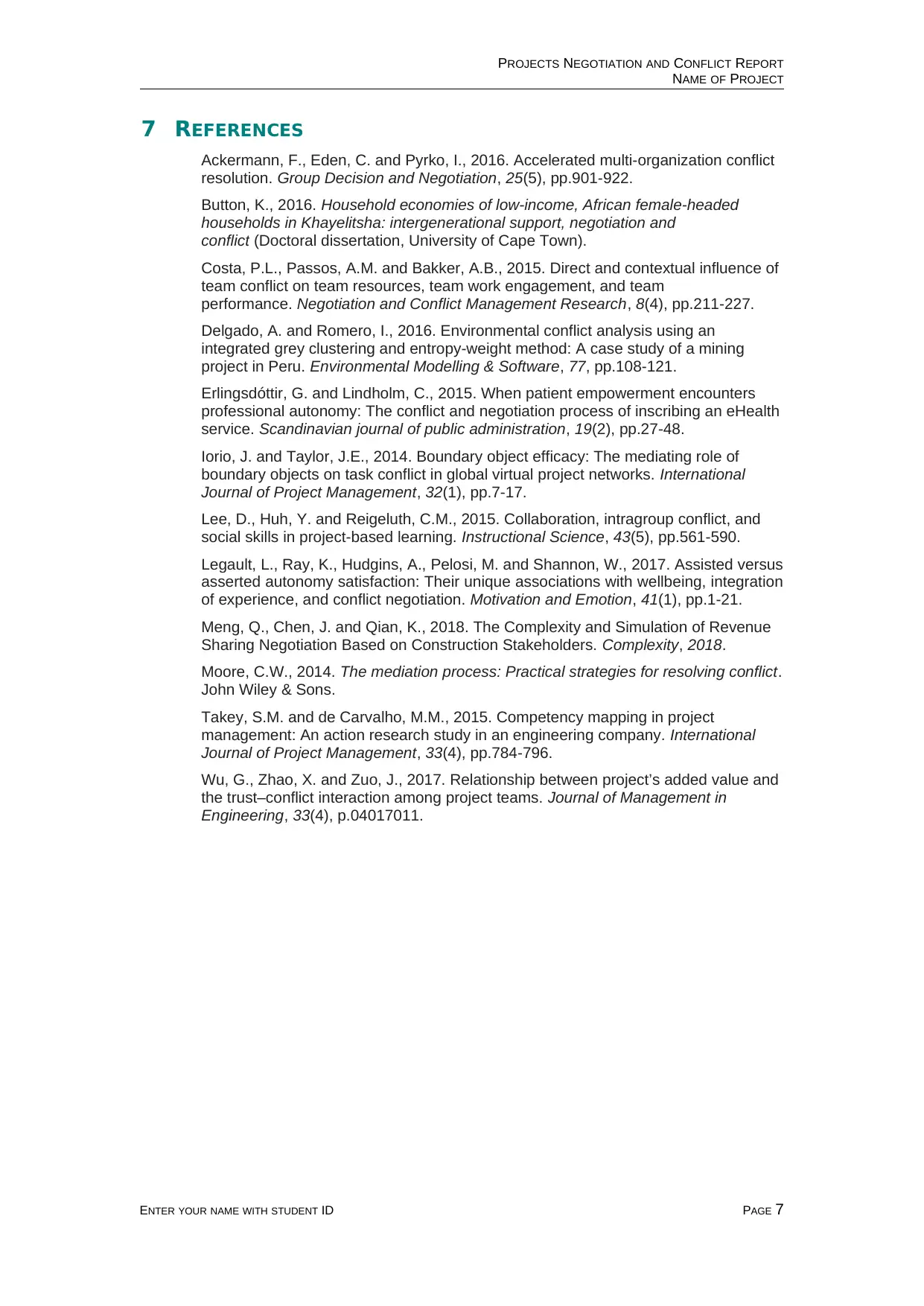
PROJECTS NEGOTIATION AND CONFLICT REPORT
NAME OF PROJECT
7 REFERENCES
Ackermann, F., Eden, C. and Pyrko, I., 2016. Accelerated multi-organization conflict
resolution. Group Decision and Negotiation, 25(5), pp.901-922.
Button, K., 2016. Household economies of low-income, African female-headed
households in Khayelitsha: intergenerational support, negotiation and
conflict (Doctoral dissertation, University of Cape Town).
Costa, P.L., Passos, A.M. and Bakker, A.B., 2015. Direct and contextual influence of
team conflict on team resources, team work engagement, and team
performance. Negotiation and Conflict Management Research, 8(4), pp.211-227.
Delgado, A. and Romero, I., 2016. Environmental conflict analysis using an
integrated grey clustering and entropy-weight method: A case study of a mining
project in Peru. Environmental Modelling & Software, 77, pp.108-121.
Erlingsdóttir, G. and Lindholm, C., 2015. When patient empowerment encounters
professional autonomy: The conflict and negotiation process of inscribing an eHealth
service. Scandinavian journal of public administration, 19(2), pp.27-48.
Iorio, J. and Taylor, J.E., 2014. Boundary object efficacy: The mediating role of
boundary objects on task conflict in global virtual project networks. International
Journal of Project Management, 32(1), pp.7-17.
Lee, D., Huh, Y. and Reigeluth, C.M., 2015. Collaboration, intragroup conflict, and
social skills in project-based learning. Instructional Science, 43(5), pp.561-590.
Legault, L., Ray, K., Hudgins, A., Pelosi, M. and Shannon, W., 2017. Assisted versus
asserted autonomy satisfaction: Their unique associations with wellbeing, integration
of experience, and conflict negotiation. Motivation and Emotion, 41(1), pp.1-21.
Meng, Q., Chen, J. and Qian, K., 2018. The Complexity and Simulation of Revenue
Sharing Negotiation Based on Construction Stakeholders. Complexity, 2018.
Moore, C.W., 2014. The mediation process: Practical strategies for resolving conflict.
John Wiley & Sons.
Takey, S.M. and de Carvalho, M.M., 2015. Competency mapping in project
management: An action research study in an engineering company. International
Journal of Project Management, 33(4), pp.784-796.
Wu, G., Zhao, X. and Zuo, J., 2017. Relationship between project’s added value and
the trust–conflict interaction among project teams. Journal of Management in
Engineering, 33(4), p.04017011.
ENTER YOUR NAME WITH STUDENT ID PAGE 7
NAME OF PROJECT
7 REFERENCES
Ackermann, F., Eden, C. and Pyrko, I., 2016. Accelerated multi-organization conflict
resolution. Group Decision and Negotiation, 25(5), pp.901-922.
Button, K., 2016. Household economies of low-income, African female-headed
households in Khayelitsha: intergenerational support, negotiation and
conflict (Doctoral dissertation, University of Cape Town).
Costa, P.L., Passos, A.M. and Bakker, A.B., 2015. Direct and contextual influence of
team conflict on team resources, team work engagement, and team
performance. Negotiation and Conflict Management Research, 8(4), pp.211-227.
Delgado, A. and Romero, I., 2016. Environmental conflict analysis using an
integrated grey clustering and entropy-weight method: A case study of a mining
project in Peru. Environmental Modelling & Software, 77, pp.108-121.
Erlingsdóttir, G. and Lindholm, C., 2015. When patient empowerment encounters
professional autonomy: The conflict and negotiation process of inscribing an eHealth
service. Scandinavian journal of public administration, 19(2), pp.27-48.
Iorio, J. and Taylor, J.E., 2014. Boundary object efficacy: The mediating role of
boundary objects on task conflict in global virtual project networks. International
Journal of Project Management, 32(1), pp.7-17.
Lee, D., Huh, Y. and Reigeluth, C.M., 2015. Collaboration, intragroup conflict, and
social skills in project-based learning. Instructional Science, 43(5), pp.561-590.
Legault, L., Ray, K., Hudgins, A., Pelosi, M. and Shannon, W., 2017. Assisted versus
asserted autonomy satisfaction: Their unique associations with wellbeing, integration
of experience, and conflict negotiation. Motivation and Emotion, 41(1), pp.1-21.
Meng, Q., Chen, J. and Qian, K., 2018. The Complexity and Simulation of Revenue
Sharing Negotiation Based on Construction Stakeholders. Complexity, 2018.
Moore, C.W., 2014. The mediation process: Practical strategies for resolving conflict.
John Wiley & Sons.
Takey, S.M. and de Carvalho, M.M., 2015. Competency mapping in project
management: An action research study in an engineering company. International
Journal of Project Management, 33(4), pp.784-796.
Wu, G., Zhao, X. and Zuo, J., 2017. Relationship between project’s added value and
the trust–conflict interaction among project teams. Journal of Management in
Engineering, 33(4), p.04017011.
ENTER YOUR NAME WITH STUDENT ID PAGE 7
1 out of 7
Related Documents
Your All-in-One AI-Powered Toolkit for Academic Success.
+13062052269
info@desklib.com
Available 24*7 on WhatsApp / Email
![[object Object]](/_next/static/media/star-bottom.7253800d.svg)
Unlock your academic potential
© 2024 | Zucol Services PVT LTD | All rights reserved.

